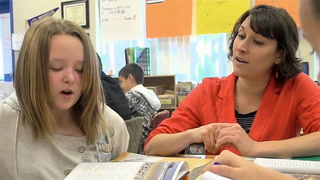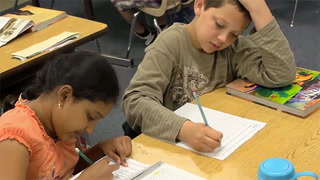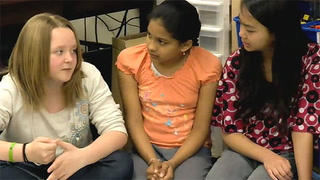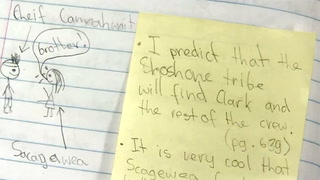TIMECODE COMMENT GRAPHICS
TEXT:
Common core: ELA
Delivering and Evaluating a Persuasive Speech
02:02:00 STACY BREWER: So after we do the small group brainstorm I ask them to come prepared for text talk time and text talk time is a discussion structure that I created in order to give the kids an opportunity to talk about a text that we had been reading during the week. TEXT:
Text Talk Time
Stacy Brewer
5th Grade teacher
Stevenson Elementary – Bellevue, WA
02:02:20 STACY BREWER: It’s an opportunity for them to call the shots and to discuss what they were thinking when they read the text. And it’s also an opportunity for me to ask questions that challenge them and that I’ll later expect them to respond to in writing. TEXT:
Common Core:
Engage effectively in a range of collaborative discussions
02:02:35 STACY BREWER: Before we get started I want to go over the expectations like we do every single time. One person speaks at a time and lately remember we’ve been kind of talking about how sometimes we get excited and we all start joining in and blurting out. TEXT:
Review expectations for group conversation
02:02:50 STACY BREWER: And that’s okay every once in a while that happens in normal conversation, but we just remember that if I call for the zero noise signal that we’re all going to come back as a group and hear one person. Listen carefully to the speaker, right?
02:03:05 STACY BREWER: You don’t know if you’re adding something if you’re not listening to what someone else said, right? So you need to listen carefully. And use hand signals, so two fingers if you have something to add onto what somebody has already said and thumbs up if you have something new to say. TEXT:
Common Core:
Follow agreed upon rules for discussion
02:03:18 STACY BREWER: I use the strategy of hand signals in order to promote active listening. I also use hand signals to help me facilitate the conversation.
02:03:26 STACY BREWER: Oh, wow, lots of thinking.
02:03:28 STACY BREWER: The strategy has been really effective because raising your hand wasn’t enough. It’s, gives students an opportunity to show me that they have something to say. Vanesha [sp] you have something new to say looks like. TEXT:
Hand Signals
02:03:38 VANESHA: Hm-hmm.
02:03:39 STACY BREWER: Okay.
02:03:40 VANESHA: I have two questions.
02:03:43 STACY BREWER: Pose them to the group.
02:03:45 VANESHA: Okay, so the first one is what happened to the ship after they left, the ship that was going to come and they waited?
02:03:55 STACY BREWER: Can we go to that part? Do you know what page it said that on so we can…. TEXT:
Common Core:
Quote accurately from a text
02:03:58 VANESHA: I think…
02:04:01 BOY: Well, we heard that in the beginning…
02:04:04 STACY BREWER: For the first 20 minutes of the conversation
02:04:06 STACY: Julio, show us up.
02:04:07 STACY: I’m just choosing students and I’m trying to give turns to an equal number of students from different parts of the circle. I’m the facilitator in this discussion.
02:04:17 STACY: Natalia, you have something to add?
02:04:19 NATALIA: I was also, on Sacagawea, it was hard probably for her because she had her baby with her and to go around that river and stuff. Like babies, like we were talking about it in our group, babies need a lot of good care and it would be hard to go through all that especially with a baby. TEXT:
Common Core:
Engage effectively in a range of collaborative discussions
02:04:39 STACY BREWER: Do we have evidence that, that Sacagawea was with them when they crossed the falls? I know…
02:04:45 NATALIA: Yes.
02:04:45 STACY BREWER: I don’t think she was with them the whole time. Devonte? [sp] Do you see where there’s evidence?
02:04:50 DEVONTE: In the picture it shows Sacagawea, she’s pointing at the falls and Lewis and Clark and a slave, they’re, like Sacagawea’s like pointing that they might die in the falls so they probably have to go around it. TEXT:
Analyze illustrations for evidence
02:05:06 STACY BREWER: And since I know that this is a narrative nonfiction and we’ve been learning about how in nonfiction the pictures and the captions, that gives us lots of information we could probably be pretty sure that Sacagawea was with them and that this picture is placed here to give us that information.
02:05:22 STACY BREWER: Next I give them questions that I expect them to write about once we’re done with text talk time.
02:05:27 STACY BREWER: Let me post these questions to you so we can get a little bit of talking about this before I send you out to write. I’m going to take us back to viewpoint. It’s not why the author wrote but how the author feels about something. TEXT:
Common Core:
Identify author’s viewpoint
02:05:39 How does the author feel about Lewis and Clark? TEXT:
How does the author feel about Lewis and Clark?
02:05:43 STACY BREWER: So will you take a minute and turn and talk to the person sitting next to you about what you’re thinking about this question? What do you think the author, how do you think the author feels about Lewis and Clark?
02:05:53 STACY BREWER: After I pose a question to the group I give the students an opportunity to turn and talk as a way to give them a few minutes to talk and think about possible answers before they feel like they need to share that with the whole group. TEXT:
Turn and Talk
02:06:05 STACY BREWER: Who thinks they found some evidence to back up what they think about how the author feels about Lewis and Clark? Let’s go to Alyssa. TEXT:
Common Core:
Reading informational texts to find evidence
02:06:14 ALYSSA: It says on page 644, from St. Louis Lewis and Clark traveled to Washington, DC and almost every time they passed through they brought bands to welcome them as heroes, which meant that like whenever they came in and everyone’s like cheering.
02:06:28 ALYSSA: And like congratulate them so like the author like put that in to make everybody feel that they are heroes.
02:06:36 GIRL: Yeah.
02:06:37 STACY BREWER: Okay, so you would say that the author, the author feels like Lewis and Clark were heroes.
02:06:41 The next question was, what is the author’s viewpoint about exploring and I provided them with the sentence frame to start their answer. The author thinks exploring is.
02:06:51 STACY BREWER: If you were going to fill in this sentence how would you fill it in? The author thinks exploring is? TEXT:
The author thinks exploring is.
02:06:58 BOY: I think it’s exciting.
02:07:00 STACY BREWER: Okay.
02:07:01 BOY: Because you could find out new stuff about different things you never knew about.
02:07:06 STACY BREWER: Okay, like here on 644 I noticed connecting with what you, what you were saying. That it’s exciting because you found things that never found before like on page 644 it says the expedition returned with numerous samples of plant and animal life that had never been seen by American scientists. TEXT:
Common Core:
Reading informational texts to find evidence
02:07:23 BOY: Especially in those times, it’s North America wasn’t North America yet it was just, it was called the New World. Yeah so it was, it was pretty interesting to them because they found new plants, new animals, new stuff they could use.
02:07:39 STACY BREWER: And on 641 I noticed that he said I found a descriptive word; they emerged from the Rocky Mountains into the lovely valley of clear water river. If an author’s using an opinion word like lovely that’s sort of showing how they feel about something.
02:07:55 STACY BREWER: So I’m thinking that I, it’s time to change gears. We need to get up and go back to our desks and start getting our minds ready for writing.
02:08:04 STACY BREWER: In today’s discussion I posed the question about how the author feels about exploring. How the author feels about Lewis and Clark. With the expectation that the students were going to pull evidence from the text just to support those statements.
02:08:16 STACY BREWER: That’s challenging work and I knew that it would, it would be pretty challenging for the students to work on individually in writing. So doing all that difficult thinking together in a group while they had support and they could hear other ideas is helpful for them.
02:08:29 STACY BREWER: And I think it makes it easier for them to write about it individually later.
02:08:33 STACY BREWER: The standards I addressed in this text talk time were speaking and listening, standard on engaging in a collaborative discussion and being prepared for a discussion. They had to come prepared, but also the reading standard of quoting accurately from a text to support your thinking. TEXT:
Tch Classroom Takeaways:
Common Core
Speaking and Listening:
1. Engage effectively in a range of collaborative discussions
2. Come to discussions prepared
3. Follow agreed upon rules for discussion
Reading Information Text:
1. Quote accurately and draw inferences
Tch Teaching Channel













74 Comments
elizabeth turnbull May 1, 2022 9:42pm
L D Mar 6, 2021 10:17pm
Love this discussion circle! I am a special education teacher working with kids who have specific learning disabilities. Currently, I don't have enough kids at one time to do this, as I work mostly with one or two at a time, but I will adapt and use this idea whenever possible. I like the idea of hand signals, predetermining the discussion questions, and sharing before writing. Great lesson!
Roberta Mobley Dec 6, 2020 12:28pm
I think that Ms, Brewer had her questions written out ahead of time and had her expectations clearly written out also helped her run the class smoothly. She must have either read the selection ahead or had the students read ahead which allowed them to be prepared for the discussion of the nformation. She asked clear and concise questions which also supported the students in their learning.
Kelsey Pratt Nov 12, 2020 1:26pm
1.) To help discussion run smoothly, Ms. Brewer incorporates a number of non-verbal cues. The students understand that they are expected to raise two fingers when they want to add onto a concept that one of their peers discusses, and they know that they should put their thumbs up if they have a new idea that they would like to share. This prevents louder students from speaking over their more reserved peers, and it provides quieter students with the opportunity to talk in an open, judgement-free zone. It is important for young students to adhere to these cues, as they need to learn that listening is just as valuable of a skill as speaking. When they truly open their ears and demonstrate a willingness to hear what others have to say, they may hear ideas that challenge their preconceived judgements.
2.) Overall, Ms. Brewer asks clear, direct questions that encourage the students to think critically. She is not just requiring for them to respond with straightforward facts from the text. Rather, she asks "What is the author's viewpoint about exploring" and "How do you think the author feels about Lewis and Clark?" This forced the students to rely upon textual evidence to support their claims. When one student argued that the author viewed exploring as an exciting activity, he referred to the text and said that the author discussed how the pair encountered new plants and animals that they had not seen in the Eastern continental U.S. Ms. Brewer encouraged this skill through requiring him to point to the exact page and paragraph where he found the supporting evidence, and this helped the student easily locate the quote when the class transitioned into independent writing time. Additionally, asking the students to think about how the author feels about Lewis and Clark forces them to think critically about what writers contribute to our understanding of historical events, and this approach primes them to consider the importance of diverse perspectives in Social Studies.
3.) It is beneficial to engage students in small group and large group discussions because it provides them with the opportunity to better develop their ideas before putting them on paper. Oftentimes, emerging writers are frustrated and overwhelmed when faced with a prompt as broad as "What is the author's viewpoint towards Lewis and Clark?" Therefore, they need an opportunity to test out their ideas in an open session without judgement. Ultimately, Ms. Brewer's 'text-talk' circles allow for the students to receive affirmation or healthy challenges in response to their ideas, and they have the chance to hear what textual evidence their peers are drawing upon to support their written claims about the author's viewpoints.
Anne O'Shea Apr 28, 2020 12:41pm
Love the activity for students to share and cite evidence. Citing evidence is a difficult skill, and teaching it in that group format is reinforcing to all students. I definitely will use this when working with my older students.